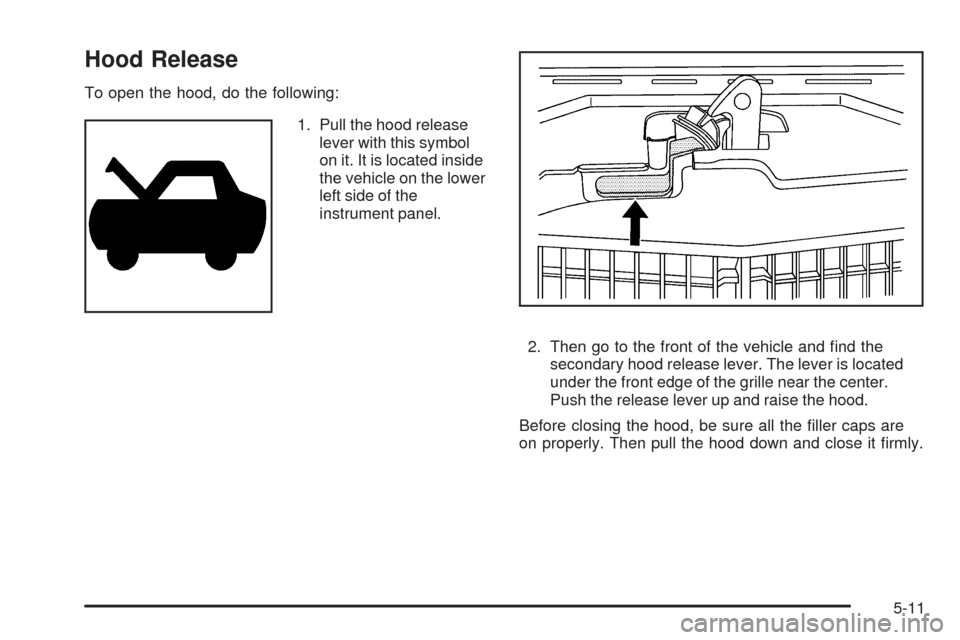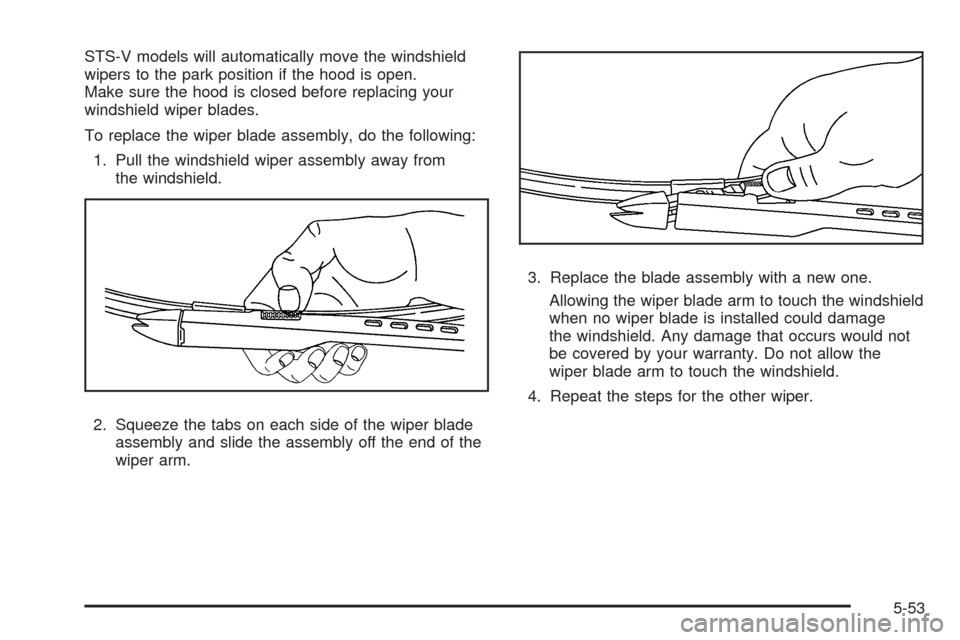2009 CADILLAC STS hood open
[x] Cancel search: hood openPage 337 of 514

Hood Release
To open the hood, do the following:
1. Pull the hood release
lever with this symbol
on it. It is located inside
the vehicle on the lower
left side of the
instrument panel.
2. Then go to the front of the vehicle and �nd the
secondary hood release lever. The lever is located
under the front edge of the grille near the center.
Push the release lever up and raise the hood.
Before closing the hood, be sure all the �ller caps are
on properly. Then pull the hood down and close it �rmly.
5-11
Page 343 of 514

After you have removed the sight shields (if equipped) on the 4.4L V8 STS-V engine, here is what you will see:
A. Underhood Fuse Block. SeeUnderhood Fuse Block
on page 5-124.
B. Remote Positive (+) Terminal. SeeJump Starting on
page 5-42.
C. Remote Negative (-) Terminal. SeeJump Starting on
page 5-42.
D. Battery. SeeBattery on page 5-42.
E. Passenger Compartment Air Filter. SeePassenger
Compartment Air Filter on page 3-54.
F. Windshield Washer Fluid Reservoir. See “Adding
Washer Fluid” underWindshield Washer Fluid
on page 5-38.
G. Intercooler System Pressure Cap. SeeEngine
Coolant on page 5-27.
H. Power Steering Fluid Reservoir. SeePower Steering
Fluid on page 5-37.I. Engine Oil Fill Cap. See “When to Add Engine Oil”
underEngine Oil on page 5-18.
J. Engine Oil Dipstick (Out of View). See “Checking
Engine Oil” underEngine Oil on page 5-18.
K. Brake Master Cylinder Reservoir. See “Brake Fluid”
underBrakes on page 5-39.
L. Engine Coolant Surge Tank and Pressure Cap.
SeeCoolant Surge Tank Pressure Cap on page 5-34
andCooling System on page 5-26.
M. Engine Air Cleaner/Filter. SeeEngine Air
Cleaner/Filter on page 5-23.
If your vehicle is equipped with front compartment
underhood sight shields, before closing the hood be
sure to reinstall the sight shields. To reinstall the shields,
locate the tabs on the left and right sides and insert them
into the openings in the tower to tower brace. Then insert
the fasteners into the top of the shield and push the
fasteners back into place.
5-17
Page 361 of 514

You may decide not to lift the hood when this warning
appears, but instead get service help right away.
SeeRoadside Service on page 7-7.
If you do decide to lift the hood, make sure the vehicle
is parked on a level surface.
Then check to see if the engine cooling fans are
running. If the engine is overheating, both fans should
be running. If they are not, do not continue to run
the engine and have the vehicle serviced.
Notice:Engine damage from running your engine
without coolant is not covered by your warranty. See
Overheated Engine Protection Operating Mode on
page 5-36for information on driving to a safe place
in an emergency.
Notice:If the engine catches �re while driving
with no coolant, the vehicle can be badly damaged.
The costly repairs would not be covered by the
vehicle warranty. SeeOverheated Engine Protection
Operating Mode on page 5-36for information on
driving to a safe place in an emergency.If Steam Is Coming From The Engine
Compartment
{CAUTION:
Steam from an overheated engine can burn you
badly, even if you just open the hood. Stay away
from the engine if you see or hear steam coming
from it. Turn it off and get everyone away from the
vehicle until it cools down. Wait until there is no sign
of steam or coolant before you open the hood.
If you keep driving when the vehicles engine is
overheated, the liquids in it can catch �re. You or
others could be badly burned. Stop the engine if it
overheats, and get out of the vehicle until the
engine is cool.
SeeOverheated Engine Protection Operating Mode
on page 5-36for information on driving to a safe
place in an emergency.
5-35
Page 369 of 514

Notice:Ignoring these steps could result in costly
damage to your vehicle that would not be covered
by your warranty.
Trying to start your vehicle by pushing or pulling it
will not work, and it could damage your vehicle.
1. Check the other vehicle. It must have a 12-volt
battery with a negative ground system.
Notice:If the other vehicle’s system is not a 12-volt
system with a negative ground, both vehicles can
be damaged. Only use vehicles with 12-volt systems
with negative grounds to jump start your vehicle.
2. Get the vehicles close enough so the jumper cables
can reach, but be sure the vehicles are not touching
each other. If they are, it could cause a ground
connection you do not want. You would not be able
to start your vehicle and the bad grounding could
damage the electrical systems.
To avoid the possibility of the vehicles rolling, set
the parking brake �rmly on both vehicles involved
in the jump start procedure. Put an automatic
transmission in P (Park) or a manual transmission
in NEUTRAL before setting the parking brake.Notice:If you leave the radio or other accessories
on during the jump starting procedure, they could
be damaged. The repairs would not be covered by
the warranty. Always turn off the radio and other
accessories when jump starting the vehicle.
3. Turn off the ignition on both vehicles. Unplug
unnecessary accessories plugged into the cigarette
lighter or the accessory power outlets. Turn off
the radio and all lamps that are not needed.
This will avoid sparks and help save both batteries.
And it could save the radio!
4. Open the hoods and locate the positive (+)
and negative (−) terminal locations or the remote
positive (+) and remote negative (−) terminals of the
other vehicle. Then locate the remote positive (+)
location on your vehicle. SeeEngine Compartment
Overview on page 5-12for more information on
locations the terminals.
5-43
Page 379 of 514

STS-V models will automatically move the windshield
wipers to the park position if the hood is open.
Make sure the hood is closed before replacing your
windshield wiper blades.
To replace the wiper blade assembly, do the following:
1. Pull the windshield wiper assembly away from
the windshield.
2. Squeeze the tabs on each side of the wiper blade
assembly and slide the assembly off the end of the
wiper arm.3. Replace the blade assembly with a new one.
Allowing the wiper blade arm to touch the windshield
when no wiper blade is installed could damage
the windshield. Any damage that occurs would not
be covered by your warranty. Do not allow the
wiper blade arm to touch the windshield.
4. Repeat the steps for the other wiper.
5-53
Page 506 of 514

G
Gage
Engine Coolant Temperature.........................3-65
Fuel..........................................................3-71
Speedometer..............................................3-57
Tachometer.................................................3-57
Garage Door Opener.......................................2-53
Gasoline
Octane........................................................ 5-5
Speci�cations............................................... 5-6
Glove Box.....................................................2-60
GM Mobility Reimbursement Program.................. 7-7
H
Hazard Warning Flashers................................... 3-6
Head Restraints............................................... 1-5
Headlamp
Aiming .......................................................5-50
Headlamp Wiring...........................................5-113
Headlamps....................................................3-32
Bulb Replacement.......................................5-51
Daytime Running Lamp................................3-36
Flash-to-Pass..............................................3-13
Halogen Bulbs............................................5-51
High Intensity Discharge (HID) Lighting...........5-51
High/Low Beam Changer................................ 3-9Headlamps (cont.)
On Reminder..............................................3-36
Washer......................................................3-16
Wiper Activated...........................................3-36
Head-Up Display (HUD)...................................3-43
Heated Seats................................................... 1-3
Heated Steering Wheel..................................... 3-7
Heater...........................................................3-48
Engine Coolant...........................................2-29
Highbeam On Light.........................................3-70
High-Speed Operation, Tires.............................5-65
Highway Hypnosis...........................................4-19
Hill and Mountain Roads..................................4-20
Hood
Checking Things Under................................5-10
Release.....................................................5-11
Horn ............................................................... 3-6
How to Wear Safety Belts Properly...................1-12
I
Ignition Positions.............................................2-26
Immobilizer....................................................2-24
Immobilizer Operation......................................2-24
Inadvertent Power Battery Saver.......................3-42
Infants and Young Children, Restraints...............1-31
In�ation - Tire Pressure...................................5-64
In�ator Kit, Tire...............................................5-87
6